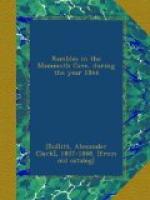the spring and near the left wall, is the place where
the oxen were fed during the time of the miners; and
strewn around are a great many corn-cobs, to all appearance,
and in fact, perfectly sound, although they have lain
there for more than thirty years. In this neighborhood
is a niche of great size in the wall on the left,
and reaching from the roof to the bottom of a pit more
than thirty feet deep, down the sides of which, water
of the purest kind is continually dripping, and is
afterwards conducted to a large trough, from which
the invalids obtain their supply of water, during their
sojourn in the Cave. Near the bottom, this pit
or well expands into a large room, out of which, there
is no opening. It is probable that Richardson’s
Spring in the Deserted Chambers is supplied from this
well. Passing the Well Cave, Rocky Cave, etc.,
etc., we arrived at the Giant’s Coffin,
a huge rock on the right, thus named from its singular
resemblance in shape to a coffin; its locality, apart
from its great size, renders it particularly conspicuous,
as all must pass around it, in leaving the Main Cave,
to visit the rivers and the thousand wonders beyond.
At this point commence those incrustations, which,
portraying every imaginable figure on the ceiling,
afford full scope to the fanciful to picture what
they will, whether of “birds, or beasts, or
creeping things.” About a hundred yards
beyond the Coffin, the Cave makes a majestic curve,
and sweeping round the Great Bend or Acute-Angle,
resumes its general course. Here the guide ignited
a Bengal light. This vast amphitheatre became
illuminated, and a scene of enchantment was exposed
to our view. Poets may conceive, but no language
can describe, the splendor and sublimity of the scene.
The rapturous exclamations of our party might have
been heard from afar, both up and down this place
of wonders. Opposite to the Great Bend, is the
entrance of the Sick Room Cave, so called from the
fact of the sudden sickness of a visiter a few years
ago, supposed to have been caused by his smoking,
with others, cigars in one of its most remote and
confined nooks. Immediately beyond the Great Bend,
a row of cabins, built for consumptive patients, commences.
All of these are framed buildings, with the exception
of two, which are of stone. They stand in line,
from thirty to one hundred feet apart, exhibiting a
picturesque, yet at the same time, a gloomy and mournful
appearance. They are well furnished, and without
question, would with good and comfortable accommodations,
pure air and uniform temperature, cure the pulmonary
consumption. The invalids in the Cave ought to
be cured; but I doubt whether the Cave air or any
thing else can cure confirmed Phthisis. A knowledge
of the curative properties of the Cave air, is not,
as is generally supposed, of recent date. It has
been long known. A physician of great respectability,
formerly a member of Congress from the district adjoining
the Cave, was so firmly convinced of the medical properties
of its air, as to express more than twenty years ago,
as his opinion, that the State of Kentucky ought to
purchase it, with a view to establish a hospital in
one of its avenues. Again the author of “Calavar,”
himself a distinguished professor of medicine, makes
the following remarks in relation to the Cave air,
as far back as 1832, the date of his visit:




